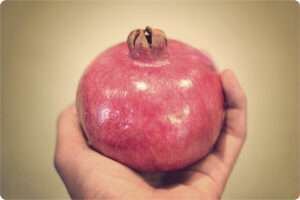Find out How to tell if a pomegranate is ripe
How to tell if a pomegranate is ripe?
The word “pomegranate” derives from the Latin words for apple and seed. It is a fruit that has been consumed by humans for millennia, but it wasn’t until the Middle Ages that we began to see paintings of pomegranates in art.
Pomegranates are a delicious and nutritious fruit that can be enjoyed all year long. Pomegranates are an iconic fruit that can be found in many grocery stores. However, if you want the freshest pomegranate possible, it is best to purchase them from a local farmer’s market or produce stand. It’s easy to tell whether a pomegranate is ripe by looking at the color of the skin and feeling for soft spots on the outside. You can also cut into one and check for seeds inside that are yellowish-orange with red streaks.

Pomegranates are a delicious fruit that can be eaten whole. A good way to determine the ripeness of a pomegranate is by shaking it and listening for a rattling sound inside. If there’s no rattle, then the pomegranate is not ripe enough and should be left on the tree until it reaches optimal ripeness. Another way to know when they’re ready is by breaking them open with your hands or using kitchen shears.
Pomegranates are an autumnal fruit that often show up in grocery stores in the later months of the year. They are a delicious, tart addition to salads and make a great snack eaten out of hand.
Pomegranates are an easy fruit to enjoy in the winter months. They’re high in fiber, vitamin C and antioxidants. The only problem is that they can be tricky to tell when they are ripe. Fortunately, there’s a simple way to figure out if your pomegranate is ready.
There are generally two types of pomegranates: dry or wet-seeded. To find out which kind you have, simply cut into it with a sharp knife around the center seed. If juice seeps from the seeds then you have a wet-seeded variety; if not then you have a dry seeded variety.
Do pomegranates ripen on the counter?
Pomegranates are a popular winter fruit. Pomegranates are a delicious and healthy fruit that are often enjoyed as is. Pomegranates don’t technically ripen on the counter, but they will continue to ripen if you leave them at room temperature. The key is to keep an eye on them and make sure they don’t get too soft or overripe. If you’re not going to eat them right away, it’s best to put them in the fridge.

pomegranates do ripen on the counter. The challenge is in knowing when they are ready to eat. As with most fruits, the pomegranate’s skin will change color as it ripens. Look for a deep red color rather than the immature greenish hue. If you aren’t sure whether the fruit is ripe or not, give it a soft squeeze a ripe pomegranate should be slightly yielding to pressure.
Pomegranates are a nutrient-rich fruit that is enjoyed by many. Contrary to popular belief, pomegranates do not need to be refrigerated in order to ripen. Pomegranates will ripen on the counter and can be stored at room temperature for up to two weeks. When choosing a pomegranate, make sure to select one that is free of bruises or blemishes and has a dull skin color.
If you’re looking for peak flavor, it’s best to consume them as soon as possible after harvest. However, if you’re not in a hurry and want to enjoy their unique sweetness, then letting them sit at room temperature for a while won’t hurt them.
What color is an unripe pomegranate?
Unripe pomegranates are smaller and have a light green color. They’re not quite as sweet as the ripe ones, but they still have that delicious pomegranate flavor. So what color is an unripe pomegranate? Light green. Keep your eyes peeled for them next time you’re at the grocery store you won’t be disappointed.

It is a common misconception that they do. A ripe pomegranate will have vivid orange or reddish-pink color and be soft to the touch, so if you are trying to find out whether your pomegranate is ripe, try pressing it gently with your finger. If it yields slightly under pressure, then it’s ready for harvest.
Pomegranates are a delicious and healthy fruit that can be eaten raw or used in recipes. There are many different ways to eat pomegranates, but some people might not know how to tell when they are ripe.
Pomegranates have been around since ancient times and were one of the first fruits to be cultivated in Europe. They’re loaded with vitamins C, K, and B6 as well as minerals like calcium and potassium.

If you’ve ever tried to eat a pomegranate that’s not ripe, you know how frustrating it can be. The seeds are hard and the juice is sour. Some people say that unripe pomegranates are redder than ripe ones, while others claim that they’re lighter in color. But the best way to find out for sure is to ask someone who’s familiar with them. So next time you see a pomegranate at the store, don’t hesitate to ask the produce vendor how to tell if it’s ripe or not.
Well, it depends on the variety of pomegranate. Some are purple when they’re unripe and others are green. No matter the color, though, pomegranates are definitely a delicious fruit.
The unripe fruit is yellow or green rather than deep red because its skin contains chlorophyll which turns yellow as it ripens. When ripe, the seeds are crimson and juicy with a tangy sweet taste. Pomegranates grow best in regions with hot weather and dry soil.
Read More:
- Black spots on teeth that aren’t cavities
- What does salmon taste like?
- Fibrous papule of the nose
- Pinprick red dots on skin not itchy
- What is the average weight of a 12 year old?

